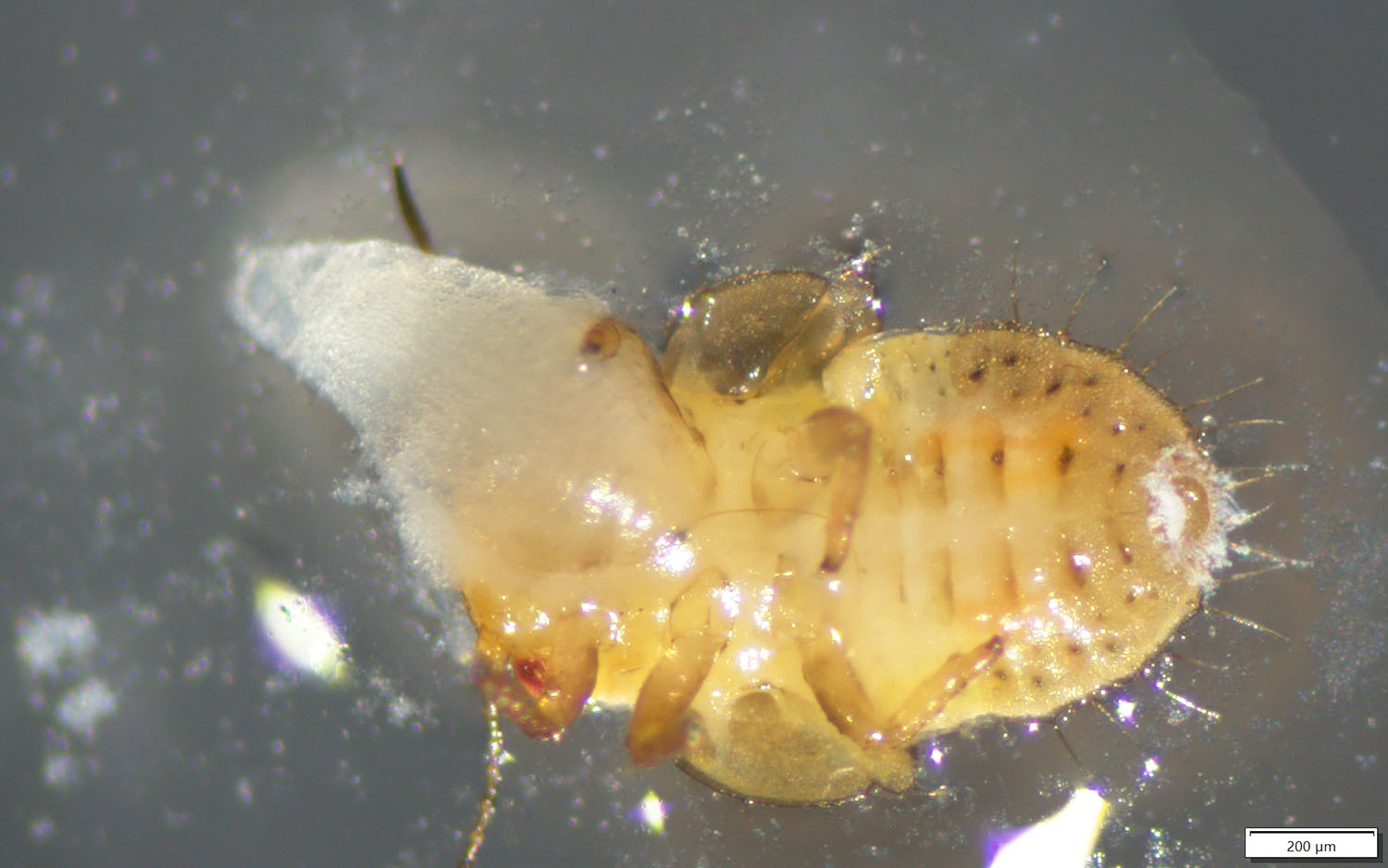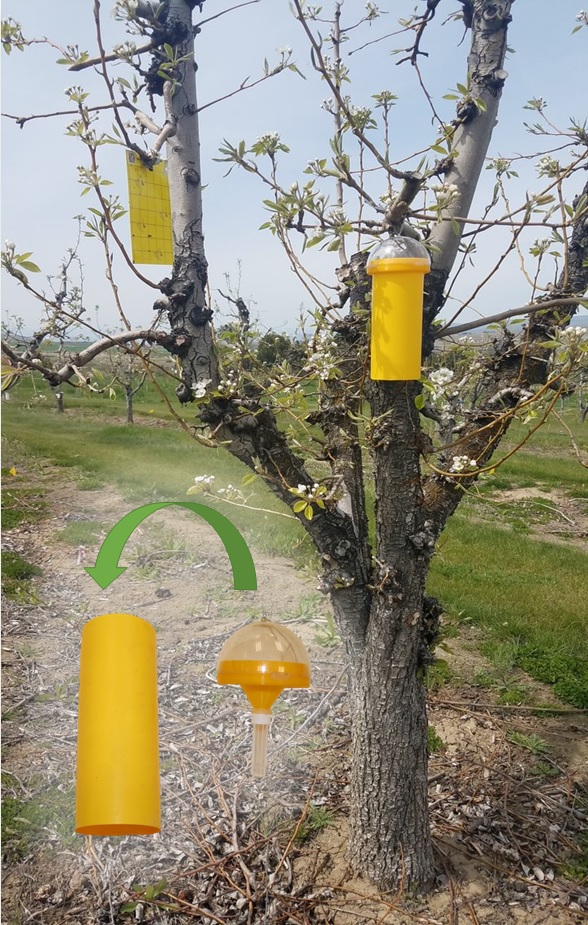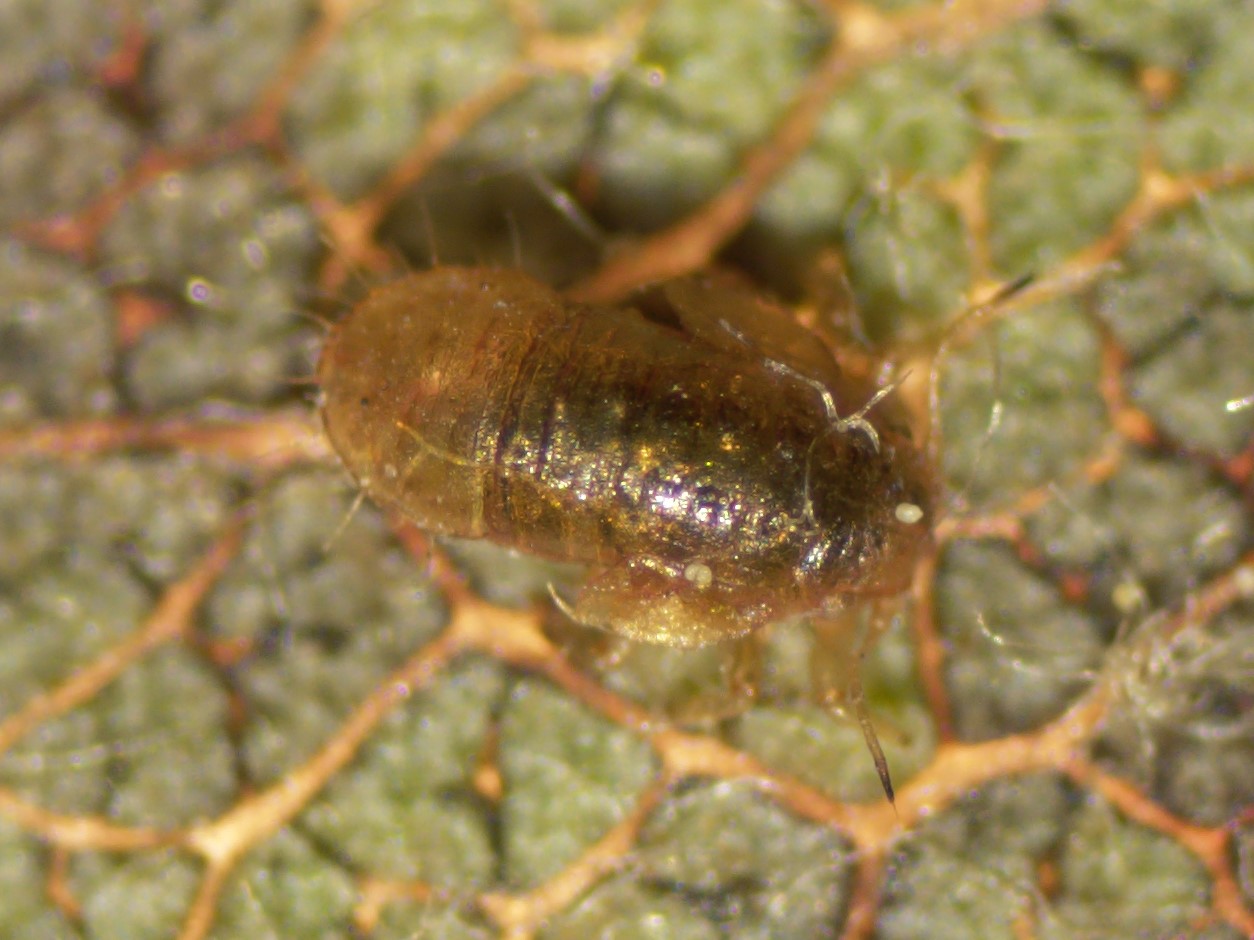Written by Rebecca Schmidt-Jeffris (USDA-ARS), Gabriel Zilnik (USDA-ARS) and Tianna DuPont (WSU), 3/20/2023
Trechnites insidiosus is the main parasitoid of pear psylla often reducing pear psylla numbers by 50%. When and how should you scout for it?
Trechnites insidiosus is a parasitoid wasp specializing on pear psylla. Up to 100% of pear psylla nymphs can be parasitized by this wasp at certain times of the year. More than 50% throughout the season is more typical in orchards where the wasp is present, based on recent USDA-ARS research [1]. Even low numbers of T. insidiosus can result in high levels of parasitism [1].

Life cycle and phenology
Trechnites insidiosus lay their eggs inside pear psylla nymphs and the developing larva kill the host and form a mummy, which can be seen on the surface of a leaf.
In Washington, T. insidiosus has 3 to 4 generations per year which coincide with pear psylla generations [1,3]. Adult emergence typically begins in April in Washington and adult counts peak 1-2 weeks after they are initially observed. In subsequent summer generations, T. insidiosus populations peak generally two weeks after pear psylla adult populations peak [1]. In the fall, parasitized psylla nymphs seek shelter (e.g., bark crevices) and form mummies starting in late September and early October [1]. By mid-November, most mummies have entered their overwintering refuge [1]. See Trechnites page for more detail.

Identification
Look for small, squat black wasps that are 1/25 inches (1 mm) long. Their main identifying feature is an upside down, blueish-green metallic triangle on their back, just above their wings. This flash of color can even sometimes be seen with the naked eye. Additionally, T. insidiosus have metallic purple eyes and pale yellow striping on their legs and antennae.
How to monitor
Adults can be monitored with yellow sticky cards or beat trays. If using beat trays as T. insidiosus is easily missed due to their small size and they can be easily confused with other parasitoid wasps. Identification under magnification is strongly recommended. Beat trays also catch fewer T. insidiosus, so you will likely drastically underestimate their presence [1]. Sticky card traps provide more reliable information [1]. You can cut down on the number of extra insects on your sticky cards (and the amount of time spent looking for the wasps) by using inexpensive tulle to screen the card and block bigger insects from getting stuck (Item 90816159, “Gold Sparkling Tulle”; Paper Mart, Orange, CA). The tulle screening is particularly useful if a location has lots of flies or honeybees that could coat the card and hide captured T. insidiosus. Adult T. insidiosus can also be monitored with 3D-printed cylinder traps [1]. See publicly available design and printing files. Antifreeze (ethylene glycol type) can be used as the catch fluid in the vials. Sticky cards or vials can then be inspected with a microscope to confirm that T. insidiosus is present and in what numbers. A lower magnification, low cost microscope can be used to examine the traps.

Pesticide effects on Trechnites
Adult T. insidiosus are more sensitive to insecticides than many other natural enemies; even softer products like Altacor (chlorantraniloprole) and Neemix 4.5 (neem) cause appreciable mortality in lab assays [1]. Integrated pest management programs which contained selective insecticides (e.g. kaolin, oil, insect growth regulators, plant extracts, azadiractin) and avoided broad spectrum materials (e.g. lambda-cyhalothrin, novaluron, thiamethoxam, malathion, esfenvalerate, acetamiprid, abamectin, pyridaben, imidacloprid, spirotetramat) have supported T. insidiosus populations [3, 4]. To minimize harm to T. insidiosus, follow the WSU pear psylla phenology model and use selective insecticides whenever possible. When T. insidiosus are in the mummy stage, they appear to be less sensitive to pesticides [5]. If using less selective sprays, time them to avoid peak T. insidiosus adult populations, which may reduce biocontrol disruption.


Contact
Rebecca Schmidt-Jeffris
USDA-ARS
rebecca.schmidt@usda.gov
509-454-6556
Gabriel Zilnik
USDA-ARS
gabriel.zilnik@usda.gov
Tianna DuPont
WSU Extension
tianna.dupont@wsu.edu
(509) 713-5346
Funding and acknowledgements
Ongoing research on Trechnites insidiosus has been funded by Fresh and Processed Pear Committee Research, Washington State Department of Agriculture Specialty Crop Block Grant K3141, and the Washington State Commission on Pesticide Registration. Mention of trade names or commercial products in this publication is solely for the purpose of providing specific information and does not imply recommendation or endorsement by the U.S. Department of Agriculture. USDA is an equal opportunity provider and employer.
Additional information
More information about T. insidiosus
The final report on a recently completed T. insidiosus research project.
References
- Schmidt-Jeffris et al. Final Project Report: Incorporating Trechnites into a psylla biocontrol program. Washington Tree Fruit Research Commission. 2023. https://treefruitresearch.org/report/incorporating-trechnites-into-a-psylla-biocontrol-program/
- Tougeron, K., et al., Ecology and biology of the parasitoid Trechnites insidiosus and its potential for biological control of pear psyllids. Pest Management Science, 2021. 77(11): p. 4836-4847.
- DuPont, S.T. and C.J. Strohm, Integrated pest management programmes increase natural enemies of pear psylla in Central Washington pear orchards. Journal of Applied Entomology, 2020. 144(1-2): p. 109-122.
- DuPont, S.T., et al., Evaluation of an integrated pest management program for central Washington pear orchards. Biological Control, 2021. 152.
- Rendon et al. Final Project Report: Ecology of Trechnites, an important parasitoid wasp of pear psylla. Washington Tree Fruit Research Commission. 2018. https://treefruitresearch.org/report/ecology-of-trechnites-an-important-parasitoid-wasp-of-pear-psylla/
Fruit Matters articles may only be republished with prior author permission © Washington State University. Reprint articles with permission must include: Originally published by Washington State Tree Fruit Extension Fruit Matters at treefruit.wsu.edu and a link to the original article.
Use pesticides with care. Apply them only to plants, animals, or sites listed on the labels. When mixing and applying pesticides, follow all label precautions to protect yourself and others around you. It is a violation of the law to disregard label directions. If pesticides are spilled on skin or clothing, remove clothing and wash skin thoroughly. Store pesticides in their original containers and keep them out of the reach of children, pets, and livestock.
YOU ARE REQUIRED BY LAW TO FOLLOW THE LABEL. It is a legal document. Always read the label before using any pesticide. You, the grower, are responsible for safe pesticide use. Trade (brand) names are provided for your reference only. No discrimination is intended, and other pesticides with the same active ingredient may be suitable. No endorsement is implied.

